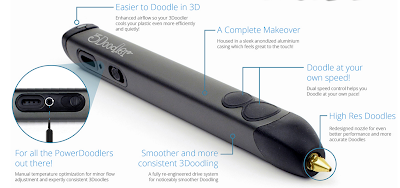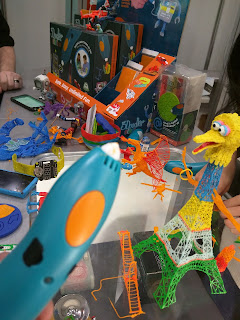3D Pens have popped up everywhere. Ok, not everywhere - like there are none in my sock drawer - but certainly in stores and online where, just a year ago, you would not have seen them.
If you have already tried a 3D Pen or bought one or generally know about them, you can stop reading now. If you wanted to understand the basics of what they are, this short post should help you.
What is a 3D Pen?

A 3D Pen is an electric tool which lets you create things out of plastic. It's a creative tool - perhaps it could even be called a toy. It is what I would call a modern version of play-dough.
Most 3D Pens take a strip of plastic "filament" into one side, heats it up to around 175 degrees Celsius (347 Fahrenheit!) and forces it out of the other side (tip) of the "pen" in a narrow stream allowing you to "draw" with it.
As the plastic dries, it hardens back into firm plastic, remaining in whatever form you created. If you've ever decorated a cake with one of those pastry bags, you pretty much know how to use a 3D Pen.
The plastic used is typically the same as that used by 3D Printers. PLA is the best option, as it has less harmful (or worrisome) fumes and melts at a slightly lower temperature (although, 345F is still pretty darn hot!). Some 3D Pens expect you to use their own "plastic sticks" - like the 3Doodler - but I prefer pens which are friendly to the same filament I'm using with my 3D Printer, so I don't have to buy separate material.
 |
| Scribber 3D Pen has a clear screen to show the settings |
Controlling the 3D Pen
There are some basic controls on most 3D pens.
Temperature is the most important, as different plastic requires different temperatures.
Speed is another option on some pens, so you can control the rate at which the melted plastic comes out of the tip.
Then there's the motion - all pens which use plastic filament have both a forward (for drawing) and reverse (for removing un-used filament) - which allows you to "draw" or stop as you want to. That's pretty much it. Simple.
World's First, and My First - 3Doodler
 |
| The 3Doodler 1.0 - the original |
The first 3D Pen I ever saw - in September 2014 at the MakerFaire in NYC - and apparently the first one ever invented, was the 3Doodler.
That first version of the 3Doodler, which I bought pretty much at first sight, was good - but not excellent - which is pretty expected given it was the "world's first". It was loud (it even has a fan in it) and bulky and had inconsistent reliability in my experience and clogged a couple of times too.
 |
| The 3Doodler 2.0 - from 3Doodler's site |
That said, the first early 3Doodler helped me understand the concept well and frankly, amazed me.
Since then, the 3Doodler company greatly improved on their original design and now sells their
second version which I don't own yet. IT has been considered by others to be a huge improvement over the first - Less bulky, quieter, more reliable.
I'll definitely try the
version 2.0 3Doodler eventually, and I have the utmost respect for this company's founders, as they really innovated and broke new ground, defining this whole product category. You can now buy the
3Doodler in almost every innovative electronic-friendly toy or game shop and even in Brookstone and other high-end retailers.
3D Pens Galore
 |
| Scribbler 3D Pen |
With 3Doodler's success in this new product category, it was inevitable that others would follow to create similar products. I've seen all sorts of variations on this theme now, but most are just basic knock-offs.
I decided to try one called the "
Scribbler 3D Pen" (3rd generation). It was highly rated on Amazon and - at the time - was on sale for $69. (As of this writing, it is $99 in all the listings I could find).
I saw one completely new 3D Pen design at the NYC Toy Fair this past February called
CreoPop - which uses liquid "ink" without heat - rather it uses LED lights to dry the ink as it emits from the pen's tip. This also seemed to allow more option in material with glow-in-the-dark, neon and more colors. This looked cool, but I haven't had a chance to try it first hand.
New 3D Pen version for kids coming
 |
| 3Doodler Start and some creations |
3Doodler is also showing and taking pre-orders for a completely new product called the
3Doodler Start.
This version operates at a much lower temperature with completely new filament which is non-toxic, making the whole kit much safer for younger kids!
I saw this product at the NYC Toy Fair in February 2016, and was VERY impressed. I expect this product to be a huge success for kids and schools if it proves to be reliable with reasonably priced filament. Nice to see 3Doodler continuing to innovate in 3D Pen Printing.
Conclusion
If you love crafts and Maker projects, and often have the opportunity to work with kids to encourage them to experiment and try new things - get a 3D Pen. Make no mistake - this tool is not for creating precision objects as you might do with a 3D Printer. This tool is mainly for creativity and art.
I haven't worked with enough different models to absolutely pick which is best and recommend a "winner" - but I will say that I've had great luck so far with the
Scribbler 3D Pen myself and have heard good things about
3Doodlers 2.0 version.
Check ratings on Amazon and Google Shopping to get a broader opinion before buying.
 The Model
The Model
















